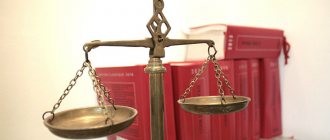Amount of compensation for moral damage: how to reduce uncertainty and increase efficiency?
The main feature of cases of compensation for moral damage is the vagueness of the criteria by which the court decides on the amount of compensation. Therefore, lawyers often work on such cases intuitively, try to use more emotional factors, do not formulate specific goals, and all this, as a result, entails a certain unpredictability of the outcome of this category of disputes.
Meanwhile, proper analysis of materials and simple research work when preparing a case allows you to initially set specific goals, better predict and evaluate the result, and ultimately achieve the most acceptable (often for both parties) compensation.
- We decide on goals.
In management theory, setting SMART goals has long been the norm. It is believed that any goal should be specific, measurable, achievable, relevant, and time-bound [1]. According to management practitioners, goals formulated with this in mind principles are more likely to be achieved.[2] This approach is universal and can be applied in legal practice in general and in disputes about moral harm in particular.
At the same time, for the category of cases under consideration, the last two characteristics (relevance and timing) usually do not cause difficulties: relevance in this case means the presence of the necessary legal grounds for obtaining compensation and the actual possibility of receiving it from the defendant (in other words, his solvency), and the time frame are largely due to the actual time frame for consideration of cases and execution of court decisions. Although the timing of receiving compensation can also be influenced during the consideration of the case. As for the first three elements, you need to work with them.
Regardless of whether the lawyer represents the plaintiff or the defendant, he needs to find out the actual figures of compensation that the plaintiff can expect. The only way to do this is to know the practice. Moreover, the practices of a specific region, and even better, of a specific court and judges.
Previously, this was quite a difficult task and in order to obtain the necessary information, it was necessary to have some connections in the apparatus of a particular court (in fact, most lawyers could not do this and relied only on their own experience). Now this is only a matter of due diligence of the representative, because on September 27, 2017, the Resolution of the Presidium of the Supreme Court of the Russian Federation approved the procedure for publishing judicial documents, which directly prohibited excluding from the texts of judicial acts the amounts of required and awarded amounts of compensation for moral damage (paragraph “d”, paragraph 3.2 Order).[3] And although this procedure is still observed by the courts selectively, starting from approximately 2018, in most published judicial acts the amounts requested and awarded have already been indicated.
Accordingly, you need to use any publicly available aggregator (I personally use Sudakt.ru), make a selection by region (in the future, also by court), enter the necessary keywords, and analyze the practice over the past year or so. Separately, it is necessary to study the practice of the second instance court: which decisions stood, in which cases the amount of compensation was changed, in what direction and why?
The result will be a number of cases, generally similar to yours. After studying them, it is necessary to summarize the data and find out the average values. The result is approximately the following table (using the example of a case of compensation for moral damage as a result of causing moderate harm to health in an accident):
| Court, decision date and case number | Judge | Circumstances | Requested amount | Amount awarded | Note[4] |
| Decision of the Industrial District Court of Stavropol dated XX.XX.2018 in case No. X-XXX/2018 | Zotov N.I. | Caused moderate harm to health as a result of an accident | 500 000 | 100 000 | |
| Decision of the Industrial District Court of Stavropol XX.XX.2018 in case No. X-XXX/2018 | Ivanov K.A. | Caused moderate harm to health as a result of an accident | 1 000 000 | 85 000 | |
| Appeal ruling of the Stavropol Regional Court dated XX.XX.2018 in case No. 33-ХХХХ/2018 | Ivanov K.A. (NB: the judge of first instance is important here, not the composition of the panel) | Caused moderate harm to health as a result of an accident | 80 000 | 30,000 (first in.), 80,000 (appeal) | |
| Decision of the Perovsky District Court of the Stavropol Territory dated XX.XX.2018 in case No. X-XXX/2018 | Perov P.P. | Caused moderate harm to health as a result of an accident | 800 000 | 400 000 | |
| Decision of the Izobilnensky District Court of the Stavropol Territory dated XX.XX.2018 in case No. X-XXX/2018 | Olgina O.V. | Caused moderate harm to health as a result of an accident | 900 000 | 90 000 |
Now it is necessary to analyze cases that differ significantly in one direction or another from other cases and analyze the reasons for this result (especially if they occurred with your particular judge or have significant similarities with your current case), and then determine the “minimum program” and “maximum program "
In addition, you need to highlight cases that are more likely to influence the judge hearing your case. In order of increasing impact, these are:
- very similar in circumstances (not only in the actual circumstances of the case, but also in indirect aspects: it seems, for example, likely that the amount of compensation from a commercial organization may be slightly higher than from an ordinary citizen or state);
- considered by the same court (the judge can informally discuss the case with a colleague and take into account his opinion);
- reviewed by the same judge;
- considered by a higher court with the decision left unchanged;
- considered by a higher court with a change in the amount of compensation (changing a decision always makes a greater impression than leaving it unchanged, since the first is an active action)[5].
We supplement the above table with notes and get its final form:
| Court, decision date and case number | Judge | Circumstances | Requested amount | Amount awarded | Note[6] |
| Decision of the Industrial District Court of Stavropol dated XX.XX.2018 in case No. X-XXX/2018 | Zotov N.I. | Caused moderate harm to health as a result of an accident | 500 000 | 100 000 | The same court, the decision was not appealed |
| Decision of the Industrial District Court of Stavropol XX.XX.2018 in case No. X-XXX/2018 | Ivanov K.A. | Caused moderate harm to health as a result of an accident | 1 000 000 | 85 000 | The same court, the same judge, the decision stood (appellate ruling dated XX.XX.2019 in case No. 33-ХХХ/2018) |
| Appeal ruling of the Stavropol Regional Court dated XX.XX.2018 in case No. 33-ХХХХ/2018 | Ivanov K.A. (NB: the trial judge is important here - see below) | Caused moderate harm to health as a result of an accident | 80 000 | 30,000 (first instance), 80,000 (appeal) | The same court, the same judge, the decision was canceled (!). |
| Decision of the Perovsky District Court of the Stavropol Territory dated XX.XX.2018 in case No. X-XXX/2018 | Perov P.P. | Caused moderate harm to health as a result of an accident | 800 000 | 400 000 | Specific circumstances of the case: the victim is a child, the culprit was drunk while on duty, the defendant is a commercial organization). |
| Decision of the Izobilnensky District Court of the Stavropol Territory dated XX.XX.2018 in case No. X-XXX/2018 | Olgina O.V. | Caused moderate harm to health as a result of an accident | 900 000 | 90 000 | The decision stood (appellate ruling dated XX.XX.2018 in case No. 33-XX.XX/2018) |
Finally, we make a selection of judicial practice for the court, leaving the decisions that most correspond to your position and excluding comments from the table. It is better to order the decisions for the plaintiff from the largest to the smallest amount, and for the defendant - vice versa. The most convincing solutions that support your position need to be highlighted and focused on. It is also better to prepare printouts of the decision texts in advance.
The results of the study must be brought to the attention of the principal and the position on the case must be agreed upon with him. This will allow him to be included in the process, provide the lawyer with the necessary informal powers during the consideration of the case (and they will be needed in this case!) and reduce the effect of surprise.
Naturally, the principal must be repeated many times that we have no case law and the court is in no way bound by previously rendered court decisions regarding the amount of compensation, but the courts often rely on them.
- We are preparing a starting offer.
The plaintiff's "starting offer" is set forth in the complaint. The defendant is in the response. At the same time, it is necessary to understand two psychological points:
- The plaintiff must overstate the desired amount, the defendant must understate.
- The plaintiff should not refer to judicial practice in the claim, but simply ask for compensation. The defendant must substantiate the response with references to judicial practice.
Let's look at these two tips in more detail.
About overestimation and underestimation of compensation. The reasons for the first point are intuitively clear to lawyers; for the most part, they do so. The famous Robert Cialdini advised to do the same in his bestseller “The Psychology of Influence”: R. Cialdini wrote that the chances of getting a positive response from your communication partner will increase if you first ask him for something much more serious than you really want, and after refusal - what you really need.[7]
However, after analyzing the judicial practice, the parties may be tempted to immediately ask for reasonable compensation. Under no circumstances should this be done. The fact is that (in most cases) except you, none of the persons involved in the case, and even (most likely) the judge, will meticulously examine the judicial practice (oddly enough, but life shows that this is so!). However, from experience, both the judge and the other party know that the plaintiff will overestimate and the defendant will underestimate their expectations, therefore, the requested compensation must be reduced, and significantly. Cases of compensation being satisfied in full are rare. As a result, the judge, having read your claim with demands for a figure of 90,000 rubles that is actually justified by practice, will certainly not consider it seriously and may well award 20,000 rubles. Thus, with your imaginary honesty you will certainly harm the client.
It is much more difficult to overdo it in the direction of overestimation, but, nevertheless, the sense of proportion should not be changed: ask for 10,000,000 rubles. For moderate damage to health from an accident in Russia means showing oneself, at a minimum, not quite adequate (and for a representative, not professional).
In general, the plaintiff should seek the maximum possible reasonable compensation based on the practice analysis, multiplied by 2 to 5 times depending on the circumstances of the case.
The defendant must act somewhat differently: excessively understating compensation is harmful, this will be considered by the court as a mockery of the plaintiff (but the defendant has already harmed him, and this is usually clear from the case). In addition, excessively low compensation can forever close the path to negotiations with victims, and this is one of the best ways for everyone to resolve the conflict (which we will discuss below). So, it seems most correct for the defendant to ask for the minimum compensation previously awarded by this or (in the absence of) neighboring courts.
About references to judicial practice. Why shouldn’t the plaintiff in his claim refer to judicial practice on the amount of compensation? R. Harris gave similar advice in his famous “School of Advocacy”. He pointed out, talking about the accusatory speech (for our case, this is similar to the statement of claim), that “Argumentation has no place in this part of the process... its main consequence will be doubt about the proof of the accusation. Facts that from their first appearance already require care, like children, must be very weak; rest assured, your diapers will not protect them from an early death. What could be stronger and more reliable than a sober statement of a simple fact?”[8] Common sense tells us the same thing. Remember point one? If the courts usually collect 70–90,000 rubles “in such cases,” how will your demand for the recovery of 500,000 rubles look? on one page with relevant excerpts?
On the part of the defendant, it is vital to bring practice. How else, if not by reference to practice, can the defendant prove his standard and most evaluative statement that “the required amount of compensation by the plaintiff is too high”?
However, the plaintiff must have the practice ready in two versions: in the form of a certificate for the court, which can be officially attached to the case file, and in the form of a printout of court decisions.
- We enter into negotiations.
So, the preparation is completed, the positions of the parties are stated. What to do now? If you approach the process in the traditional way, insisting on your demands and appealing to legal norms, the plaintiff will actually let the matter take its course: it is impossible to present to the court specific figures to which the plaintiff is certainly entitled (as, for example, in the case of compensation for material losses) and even some calculations[9]. The defendant is in a somewhat better position, because he can, at a minimum, refer to judicial practice and ask to determine the amount of compensation taking it into account, and not based on the plaintiff’s requirements. Nevertheless. The court, as is known, is not bound by decisions in other cases.
In this regard, the best way for all participants in the process is negotiations, because they are all interested in the most convenient outcome for themselves. Thus, it is in the interests of the court to resolve the case with as little effort as possible and with minimal risk of reversal. The plaintiff wants to receive as much compensation as possible, but is almost always prepared for a significant reduction in the amount. It is in the interests of the defendant, finally, to pay as little as possible, and at the same time he fears that the collected amount may turn out to be significantly more than what he expected and which is recovered in similar cases (what if?) [10].
All these considerations make the negotiation tactics for working on the case one of the most optimal. Of course, it is impossible to describe the entire methodology of this approach in one publication, and there are many wonderful books on negotiation techniques. Here I would like to note some nuances specific to this category of cases.
What is the best way to enter the negotiation stage? The plaintiff, having heard the defendant’s disagreement with the amount of compensation, must ask him a question about what amount the defendant considers reasonable. Moreover, it is advisable to obtain a specific answer from the defendant. The respondent may try to refuse to answer the question asked, but he needs to be pressed. A case where the defendant does not name specific figures must be interpreted and presented to the court as opportunistic behavior of the opposite party. In other words, an attempt should be made to use this behavior of the defendant to demonstrate to the court who is “more right” in a given situation. In this case, the issue of the amount of compensation for moral damage will de facto be resolved in a psychological dialogue between the court and the plaintiff. With a high probability, such behavior will not be beneficial for the defendant, since he, having taken a passive position, will actually withdraw himself from participation in resolving the issue on the merits (however, this does not completely exclude the simple fact that the defendant may simply be lucky and the judge will take a position that is objectively advantageous specifically to the defendant - this also happens, but with the same success the defendant could simply not go to the hearing, because this way you can “win” the process).
Between trials, the plaintiff’s representative is interested in establishing a dialogue with the defendant and asking him the following:
- Is the defendant ready in principle to pay voluntarily and negotiate?
- If so, what amounts does he consider reasonable and can he agree to a settlement agreement on terms that would be beneficial to him?
- If not, then what is the reason for the defendant’s desire not to make compensation voluntarily? Here, the plaintiff will be helped by judicial practice, which will allow him to demonstrate to the defendant the maximum amount of compensation and more colorfully describe his risks.
In general, the main idea that needs to be conveyed to the defendant’s representative is that it is more profitable for all parties to agree on an acceptable amount of compensation and fix a certain result than to surrender to the discretion of the court and receive an inconvenient decision (the court is unpredictable and can “shoot” both in one and the other direction).
The court can also help encourage negotiations to conclude a settlement agreement. The first party to talk about this will receive some psychological bonus (and in a case of compensation for moral damage there is always a lot of psychology, so such bonuses need to be multiplied!). As you know, judges like this outcome of the case, because it has a number of advantages for them: there is no need to write the text of the decision, there is less likelihood of an appeal and the decision being overturned by a higher court.
The defendant can also initiate negotiations by drawing the plaintiff's attention to the fact that his desires are unrealistic and appealing to figures from practice. An additional argument in favor of a settlement agreement is the speed at which a court decision enters into legal force and the fact that a settlement agreement in practice is more often actually implemented than court decisions on the collection of funds (here you can provide the plaintiff with data from the bailiff service).
At the hearing, the defendant, unlike the plaintiff, must present judicial practice to the court (of course, in a favorable light [11]), directly setting it out in the response, and preferably naming specific figures for compensation acceptable to the defendant, and the maximum amount of compensation, acceptable to the defendant (of course, they should not be named directly: it is enough to indicate the case with the maximum compensation recovered in a similar case, with reasons why in your case the amount should be less). As a result, the court will understand the limits of a “safe” decision (in terms of appeal) on the part of the defendant and, in any case, will take them into account.
As a result of all these actions, the following situation should arise:
- the real limits of the dispute are more or less clear based on judicial practice and the real expectations of the plaintiff and defendant;
- the prospects for a settlement agreement are clear (is it possible and under what conditions?).
If the parties are fundamentally ready for a settlement, then they will most likely come to an agreement. If this does not happen, then the work done by both parties (or at least one of them) will reduce the likelihood of the court making a decision that differs significantly from the established judicial practice.
Conclusion.
I would like to note that the court, although it does not participate in the negotiations, always closely monitors them and draws its conclusions. A party that unreasonably avoids participating in them, or puts forward obviously unacceptable demands, as a rule, sharply loses points in the eyes of the court, therefore, such tactics are disastrous for the evading party. But a lot really depends on the court’s opinion in such cases! Participants in the process, as a rule, intuitively understand this and try to avoid such behavior, therefore, as a rule, it is enough for one party to initiate negotiations, and they are likely to take place. The main thing is not to give up and consider different options.
The method presented in the publication was repeatedly tested by the author in cases of compensation for moral damage due to the death of loved ones or serious injuries as a result of an accident, and gave good results. After the end of the process, despite the difficult initial situation, as a rule, the parties come to a compromise, and the initially existing negative becomes much less acute. Not to mention the fact that the plaintiff receives, and the defendant pays, the amount of compensation that both parties consider fair (or at least acceptable).
[1] See, for example: SMART / SMARTER, Wikipedia. Retrieved 03/07/2020 from the link: https://ru.wikipedia.org/wiki/SMART
[2] We can take the liberty of asserting that goals that do not meet these criteria are generally anything but goals.
[3] See Official website of the RF Armed Forces. Retrieved 03/07/2020 from the link: https://www.supcourt.ru/files/24014/
[4] We fill out this section at the next stage.
[5] The list can be continued by including the item “cases considered by a higher court with a change in the amount of compensation, initially considered by this judge” (its “cancellation”), but the meaning already seems to be clear.
[6] We fill out this section at the next stage.
[7] R. Cialdini. Psychology of influence. 5th edition. St. Petersburg, “Peter”, 2014, p. 63
[8] R. Harris. “School of Advocacy”, Chapter X “On the charge in court”, received 03/08/2020 from the link https://royallib.com/read/garris_rihard/shkola_advokaturi_rukovodstvo_k_vedeniyu_gragdanskih_i_ugolovnih_del.html#662071
[9] What has been said, of course, should not be understood as advice to neglect traditional legal work in the process: it is implied by itself and cannot be abandoned. Another thing is that it is absolutely not enough in this category of cases.
[10] We are not considering cases where there is a dispute about the existence of grounds for compensation for moral damage in principle, since they are not related to the subject of the publication and will only complicate its perception.
[11] Need I say that dumping the entire practice “over the hill” is unprofessional? Naturally, there is no need to present the most unfavorable solutions; let your opponent look for them - we have an adversarial process, after all!
What does the civil code say?
Physical or moral suffering in civil law is called moral harm, which violates the intangible rights and benefits of a person. Intangible benefits include life, health, personal dignity, reputation, privacy, family or personal secrets. Intangible rights are copyright, the right to use a name. And also moral damage can violate human property rights. Moral damage may result in liability, the scope of which is determined by a court decision.
A person may receive moral damage after certain events, namely:
- Deaths of loved ones;
- Inability to lead a normal life;
- Job loss;
- Disclosure of medical confidentiality;
- Slander, defaming the reputation of a citizen;
- Physical pain from injury;
- Illnesses due to experienced negative events.
Moral suffering, influencing the mental and physical health of the individual, determines the nature of physical and moral suffering. Based on this, they can be divided into degrees:
- Mild suffering. Short-term negative emotions that do not leave serious consequences in the future;
- Moderate suffering. Long-term, they can have an impact on the psycho-emotional balance of the individual during memories. Does not have consequences for the future of the victim;
- Heavy. Cause mental disorders and must be accompanied by appropriate treatment;
- Particularly severe suffering. Causes serious damage to a person's personality. As a result, a serious mental disorder may develop;
- The experienced situation can completely break a person’s psyche and is accompanied by a disintegration of personality.
For a more complete assessment of these concepts, there are a number of signs:
- The power of suffering;
- Duration;
- Level;
- Content (development of certain complexes that require a different approach to their correction).
And also when assessing moral damage, the duration of negative experiences and their impact on the future life of the victim are taken into account.
PROPERTY STATUS OF THE CAUSE OF HARM
In accordance with paragraph 3 of Art. 1083 of the Civil Code of the Russian Federation, the court has the right to reduce the amount of compensation for moral damage taking into account the property status of the tortfeasor (the defendant), except in cases where the damage was caused by his intentional actions. Based on this rule, higher courts may reject the arguments of the defense’s complaints about reducing the amount of compensation for moral damage, taking into account the property status of the defendant in criminal cases of intentional crimes.
Sometimes courts do not take into account the property status of defendants when they are required to do so, for example, in criminal cases of reckless crimes.
If the defendant is able to work, his lack of work or money at the time of consideration of the criminal case by the court is not regarded as a basis for reducing the amount of compensation
From practice.
T. was convicted under Part 3 of Art. 264 of the Criminal Code of the Russian Federation. 500 thousand rubles were collected from him. compensation for moral damage. The appellate court reduced the amount of compensation to 350 thousand rubles. with reference to clause 3 of Art. 1083 of the Civil Code of the Russian Federation, as well as the requirements of reasonableness and fairness, indicating that the court of first instance formally referred to taking into account the financial situation of the defendant, but did not actually take it into account. T. works as a salesman, his salary is 5 thousand rubles, he has 5 children (4 of them are minors), T.’s wife is on maternity leave, the family is experiencing financial difficulties and has obligations on a loan for personal purposes. consumption. At the same time, information about the welfare of the defendant was not presented to the court (appeal ruling of the Supreme Court of the Udmurt Republic dated July 16, 2013 in case No. 22-1711/2013).
When assessing the property status of the defendant, the courts examine, in particular, the defendant’s ability to work, whether he has a job, another permanent source of income, property from which compensation can be paid, as well as the presence of family members or relatives dependent on the defendant (wives, including state of pregnancy, children, elderly parents, etc.). Moreover, if the defendant is able to work, his lack of work or money at the time of consideration of the criminal case by the court is not regarded as a basis for reducing the amount of compensation (cassation ruling of the RF Armed Forces dated October 19, 2009 in case No. 45-009-106, appeal rulings of the RF Armed Forces dated 07/08/2015 in case No. 18-APU15-22, Bryansk Regional Court dated 08/14/2015 in case No. 22–1238).







